Festivals
London Film Festival 2010:
The Sight & Sound blog
It’s a wrap: we tally our festival experiences
Best new film discovery

Father (Aita)
Kieron Corless: Father (Aita), a Spanish film directed and co-scripted by Jose Maria de Orbe. Anything produced by Luis Minarro is always going to be worth watching, but this film had the added bonus of being co-scripted by Daniel Villamediana , director of this year’s La Vida Sublime, a humorous, perfectly weighted meditation on history and myth apropos contemporary Spain.
Orbe’s film is similarly preoccupied with memory, and the past in the present, here literally expressed and incarnated by an ancient Basque family home with a church and cemetery appended. Orbe’s patience and refusal to hurry or draw any obvious conclusions means Father hasn’t, unfortunately, a snowball in hell’s chance of being distributed in the UK.
James Bell: This would have to be the Romanian director Andrei Ujica’s fascinating three-hour long documentary The Autobiography of Nicolae Ceaucescu, which is made up entirely of archive footage, much of which was originally shot with the intention of glorifying the Romanian dictator, but which seen now exerts an appalling, gripping fascination. The best documentary I saw all year.
Nick James: Raul Ruiz is, of course, nobody’s ‘discovery’ but his superb four-and-a-half-hour film of Camilo Castelo Branco’s novel The Mysteries of Lisbon makes me realise I am addicted to a certain kind of Portuguese cinema that Branco’s fiction has often nourished (he’s a favourite novelist of Manoel De Oliveira’s too).
Nick Bradshaw: Lewis Klahr’s cut-out collage films, which I’ve been meaning to catch up with for a long time. I saw his Tate retrospective of Engram Sepals (Melodramas 1994-2000), which he dubs “a trajectory of American intoxication”. The films ranged from the melodramatic meta-noir of Altair (1994) (per Klahr’s notes: “I feel it is important to add that what interested me in making this film was very little of what is described above, but instead a fascination with the colour blue and some intangible association it has for me with the late 1940s”) to a fantasy disquisition on the hidden sexuality of Superman’s pal Jimmy Olsen (Pony Glass, 1997) via a beautiful cut-up of Klahr’s home-movie footage of his brother’s “glorious hippie wedding” (Govinda, 1999).
Klahr observed the films’ disquisitions on an American mythology of forming identities around excess – romantic love, even substance-taking – and worried about where that pioneer spirit was now heading.
Isabel Stevens: Uncle Boonmee Who Can Recall His Past Lives.
Favourite film moment

Compline
James Bell: In a film full of thrilling, rub-your-eyes-in-disbelief moments, the scene in Apichatpong Weerasethakul’s Uncle Boonmee Who Can Remember His Past Lives where a princess copulates with a catfish has to be the most memorable.
Nick James: In Joanna Hogg’s Archipelago, when the hired cook is putting away her knives after a testing week with her upper middle-class employers in a Scilly Isles holiday house. You just know what she'd really like to be doing with those knives.
Nick Bradshaw: Several moments of transcendent cinematic beauty in Nathaniel Dorsky’s three reverential films at this year’s festival, not least in Compline, his farewell to Kodachrome, “a noble emulsion… I have used since I was 10 years old.”
Kieron Corless: The restoration of Manoel de Oliveira’s Rite of Spring (1963) was something to behold – the deep blue of those spring skies alone were worth the trip. Shot entirely outdoors, Rite of Spring depicts an annual passion play put on by the inhabitants of a Portuguese village. Geoff Andrew’s introduction linked the film to Kiarostami and Pasolini, and I also found myself thinking of more recent films like Miguel Gomes’ Our Beloved Month of August and Albert Serra’s Birdsong.
It was intriguing to see the names of Paolo Rocha and Antonio Reis on the credits, both of whom went on to become influential directors in their own right. Working with non-professionals was an important aspect of Reis’ films, in turn a huge influence on Pedro Costa – clearly there’s a strong lineage of mixing documentary and fiction, and working with real people in their own environments, in Portuguese cinema.
Surprisingly, this film provoked more heated discussion afterwards than any other I attended at this year’s LFF. One companion found the film – and in particular the ending – pompous and didactic, and felt the non-professional villagers were patronised. I didn’t agree, but still it goes to show how fine the margins can be in - for want of a better word - ethnographic cinema.
Isabel Stevens: A century on, witnessing the tragic end to Scott’s Antarctic mission in the final scenes of The Great White Silence (1924). You would have heard a pin drop in the cinema during the haunting a cappella accompaniment of Abide with Me.
Favourite off-screen moment

The Great White Silence
James Bell: For me this came about 30 minutes into the Gala screening of the BFI’s remarkable new restoration of Herbert Ponting’s The Great White Silence, which documented Scott’s ill-fated expedition to the Antarctic. We watched as the footage recorded the boat setting off from New Zealand and crossing the Southern Ocean, when all of a sudden the camera spots an enormous iceberg appear on the horizon - colossal, imposing, dwarfing the men on the boat, as though a portent of the tragedy to come. There was a spine-tingling audible gasp throughout the audience, as we marvelled at both this priceless record of an heroic moment from the past past, and also at the magnificence of the footage.
Isabel Stevens: Magnetic Fields’ frontman Stephin Merritt talking musicals and live soundtracks to silent films after the screening of Strange Powers, the documentary about him and the band.
Nick James: This is shameless but it was being ushered into a team photo at the LFF awards by my filmmaking pals Clio Barnard and Tony Grisoni. Clio later cleaned up with two awards.
Nick Bradshaw: After the screening of his magnificent pastorale Le Quattro Volte, Michelangelo Frammartino countered the usual dictate never to shoot films with children or animals. “In all seriousness, every director should direct a goat,” he told the audience. The dog in the film was a pro – he won this year’s Palme Dog at Cannes – and “all the villagers brought their bitches out to try and get near him.”
Best (personal) encounter

David Gatten’s Journals and Remarks
Isabel Stevens: Interviewing John Akomfrah about Mnemosyne and The Nine Muses.
Nick James: Interviewing Romanian director Cristi Puiu about his new film Aurora. Ths was easily the most pleasurably erudite encounter with a director I’ve had for some time.
Kieron Corless: A one-hour, one-to-one interview with Apichatpong Weerasethakul, particularly when he got on to the subject of how much he loved US horror films.
Nick Bradshaw: Talking with US experimental filmmaker David Gatten after a screening at the National History Museum’s Darwin Centre of his new film Journals and Remarks, a filmic reprise of Darwin’s Voyage of the Beagle to the Galapagos Islands that also put into structuralist action an unrealised idea of Leonardo da Vinci’s concerning the division of an hour into 3,000 equal parts, which had led Gatten to construct his film out of 700 shots uniformly 29 frames long. (He’d also given it a back-and-forth, see-sawing if not sea-sickening rhythm. Heretofore a long-take specialist, he told the audience he’d felt he’d been repressing his use of the cut before this film – “and you know what happens when you repress something.”)
Afterwards I went to ask him how I could catch up with his earlier 16mm films. Were they available on DVD, or did he have a technological or ideological objection to that? No technological objection any more, he said, having seen the quality of Blu-ray and modern projectors; but he still felt public screenings lent a quality of attention that was hard to replicate at home. “There’s a reason people still go out to church rather than just praying it home,” he offered. But no, he was certainly looking into making video transfers, and would probably bring them out when cinema is finally dead.
Week two: Black Swan, Mysteries of Lisbon,
Dear Doctor – and The Boss
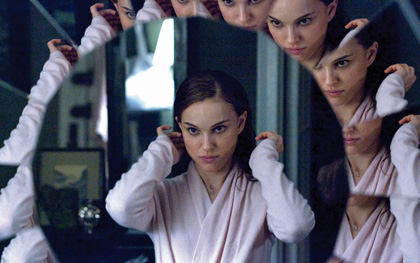
Nick James, 1 November
In the first week of the LFF, we at S&S were putting the December cover date issue to bed. So it was only in the second week that I got into the festival groove. What follows are my impressions of that dizzying week (Friday 22-Friday 29 October) of films and other fun.
I was at the Jameson gala on the 22nd for Darren Aronofsky’s Black Swan (pictured above). I’d already seen it just days beforehand at a press screening and wanted to see again in preparation for an interview with Aronofsky. A second viewing of this deliberately claustrophobic ballet tragedy makes one more aware of the amount of CGI face-switching that goes on between Natalie Portman’s uptight lead dancer Nina, Mila Kuni’s earthy rival dancer Lilly and Winona Ryder’s washed-up dancer Beth. All this doppelganging reflects what’s going on inside Nina’s overspilling paranoid imagination. Considering all his works so far, it’s clear that Aronofsky likes his meanings to overspill – he doesn’t want too much doubt or calculation clouding our minds.
This particular audience seemed over-awed by the time the director, plus actors Kuni and Vincent Cassel, returned for a Q&A. A dancer from the Royal Ballet in the audience confirmed that ballet life really can be as hyper-melodramatic and stereotypically fraught with neurosis as the film portrays. The following day I interviewed Aronofsky at a Knightsbridge hotel. He’d been up most of the night dancing with British friends in a club, something he said he almost never does, and I don’t suppose he was throwing ballet shapes or searching for his double. However, he did look as pale as Portman in face powder.
Hong Sangsoo’s latest, Oki’s Movie, pretends to be a portmanteau of four short films by three characters caught in a love triangle. At the apex is Oki, a female filmmaking student, who wins the attention of a male student and an older teacher. Funny and warm as all Hong’s films are, their charm seems to be thinning with each new entry. Structurally and in terms of situation comedy, they’re always interesting, but one can spend time with more engaging people than these tentative, half-hearted, half-drunk romantics.
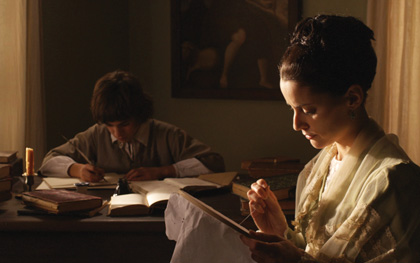
If I much preferred Raul Ruiz’s 270-minute Mysteries of Lisbon (above), it’s partly because I feel bewitched by a certain variety of Portugese cinema whose charms are hard to describe. I saw Mysteries in two parts with several days between them, the first at a press screening, the second at the Festival’s Cine Lumiere presentation. At the latter, producer Paolo Branco told us about Ruiz’s ability to get complex tracking shots right first time with a young cinematographer (André Szankowski) he’d never previously worked with.
Ruiz has made a huge variety of films, but the work that Mysteries most resembles is his elegant Proust adaptation Time Regained. Adapted from a Gothic influenced novel by Camilo Castello Branco (no relation) concering the progeniture an orphan boy called João, it’s a breathless narrative of passion, jealousy and intrigue that constantly revises itself as it unfolds and offers new versions of what we think we know, so that very little can be taken for granted. It combines a brilliant non-plussing formality of approach to drama with gorgeous Carravaggio-inspired lighting. I can’t wait to see it again, though I’m aware that its gas-and-air mix of formal games and inescapable melancholy won’t appeal to everyone.
Much less engaging was the film that followed Mysteries at the Ciné Lumiere, Memory Lane. A charmed circle of young friends from the south-west suburbs of Paris spend one summer hanging out while wrapped up in series of overlapping emotional dilemmas. All this is recalled by a handsome pivotal young manwho sings in a band with some of the friends. The director, Mikhäel Hers, gives us a strong and moody sense of place, but his cute-looking characters evince a namby-pamby preciousness that’s amplified by the band’s truly sappy songs. Hers himself proved an ultra-shy presence during the Q&A, but fortunately actress Dounia Sichov – on this evidence a better performer than Thibault Vinçon in the lead role – was on hand to help to explain Hers’ Rohmeresque methods.
Monday lifted off with a searching, ruminative interview with Cristi Puiu, the director of Aurora, a three-hour character study of a man who decides to commit murder. Puiu was very clear about the reasons why he decided to play the character himself (you’ll have to wait for the relevant issue of the magazine to find out what they are). But it has become a strange sub-phenomenon of contemplative festival-friendly cinema that non-acting directors like Puiu, Ceylan and Mundruzsco have felt that they had to be the lead figure in one of their own films.
The elation I felt from the interview left me as soon as I started watching Sergei Loznitsa’s My Joy. This properly weird road movie about a truck driver whose life is completely distorted by his experiences in the backwaters of Russia was inventive and darkly funny in places, but its preference for allegory over people made it feel too inert. In this version of Russia, pain is arbitrarily dished out to all, but the film lacks any moral justification for its own nihilistic disinterest.
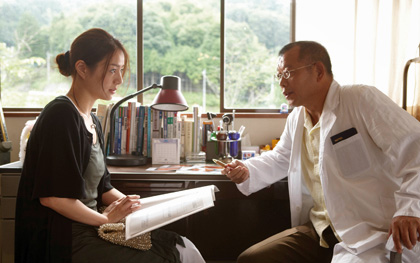
For a backwater portrait I preferred the modest Japanese film Dear Doctor (above), directed by Miwa Nishikawa. It starts with the sudden disappearance of Ito, the doctor of a small rural community, but then flashes back to a situation that would do for Peak Practice: Soma, a flashy young sports-car-driving graduate doctor, arrives at the country medical centre where Ito does things as much by intuition as by medication. However broadly comedic its intentions might at first seem, Dear Doctor turns out to be a rich character study with an immensely subtle insight into the meaning of the bedside manner.
The first half hour of the Vietnamese film Don’t Be Afraid, Bi! threatened to be a cutesy childs-eye-view of such family miseries as a father who never comes home until he’s drunk, a deeply frustrated mother, and a doting schoolteacher aunt who has a crush on one of her teenage pupils. But once the boy’s grandfather turns up to die slowly amongst them, the film’s loose structure of heat-induced high tension and vivid passionate encounters becomes increasingly explicit and compelling. First-time director Phang Dang Di deserved the film’s mention as a runner-up for the festival’s Sutherland Award.
The BFI LFF Awards are a newish proposition, only in their second year. One might think that there’s a surfeit of such events, but what distinguished this occasion were the clusters of real directing talent in the room and the collegiate atmosphere – there was none of that competitive rancour that sometimes disfigures the British Independent Film Awards. It was great, for instance, to take in the rare sight of three British women directors in a huddle – Antonia Bird, Joanna Hogg and Clio Barnard. To my delight, the latter’s The Arbor won two awards (Best Newcomer and the Sutherland Prize), and I was also pleased for Alexei Popogrebski, able to pick up his Best Film award for his splendid Arctic isolation drama How I Ended the Summer in person after failing to get a visa to attend his prior festival screenings. The cake’s icing was brief cameo from Martin Scorsese in which he praised the work of the BFI National Archive.
On closing night, Thursday 28, I skipped Danny Boyle’s 127 Hours, which I’d seen a week beforehand, and went straight to the party. The film, about Aron Ralston, the climber who got his arm pinned by a rock after a crevasse fall, is Friday-night adrenaline-shock entertainment, with a winning performance from James Franco. Primarily it’s a technical tour de force in how to make a fuzzily engaging film about a man who can’t move. The initial crush at the party also encouraged stillness, but everyone seemed to be in a pleasant end-of-term mood, with many espousing optimism despite the bleak financial prospects for the arts. It was a good way to end.
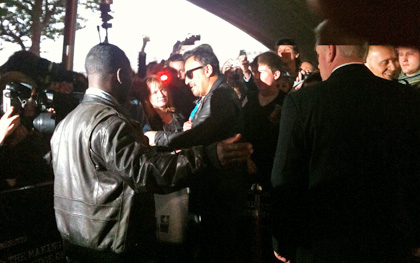
But after all that, it was bizarre indeed to be at BFI Southbank the very next day (Friday 29) to find its riverfront mobbed by rock-music fans. The occasion was a preview screening of The Promise, a documentary about the making of Bruce Springsteen’s 1978 album Darkness on the Edge of Town, and the coup was that ‘The Boss’ himself was in attendance for a Q&A. I’m old enough to remember when that album came out and the powerful impact it had on what was then the post-punk, New Wave rock scene.
The documentary was fascinating for fans, but must have been a little obtuse for those who are unfamiliar with Darkness, a melancholic album of blue-collar angst. Only brief fragments of the songs were played – snatches caught by a camera-wielding friend of the band at the time. What most fascinated was the way Springsteen was working: he and the E Street Band recorded around 70 songs, and arrangements kept shifting while the more melodic songs (for instance, Fire and Because the Night, both of which became hits for other artists) were rejected in favour of austere, riff-driven anthems (the shock of punk still feeling fresh in America at that moment). Springsteen, 27 years old, was working out of a huge book of ideas and lyrics and trying to retain total control over something he could hear in his head but didn’t know how to manifest in a recording.
Springsteen attended the after-party but was besieged throughout by fans wanting mementos. I met his manager, Jon Landau, who’d once been a movie critic for Rolling Stone. He told me almost proudly that he was the only critic dumb enough to have panned The Godfather on its release. Now that’s my kind of festival finale.
Two very different sports documentaries:
Fire in Babylon and Boxing Gym
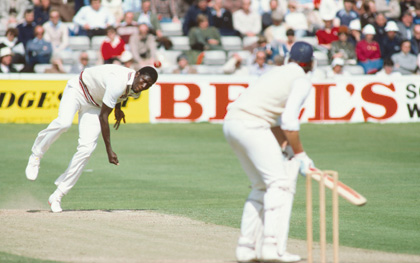
Isabel Stevens, 27 October
Bringing just a bit of the atmosphere of the stands at Sabina Park, Jamacia and the Kensington Oval, Barbados to Screen 5 at the Vue Leicester Square, the crowd at the Fire in Babylon premiere was rather more boisterous than that at your average screening. Introducing Stevan Riley’s documentary, programmer Michael Hayden drew a chorus of boos with his admission that he didn’t much like cricket. For most people in attendance, this film about the all-powerful West Indian cricket team of the 1970s and 80s was the must-see film of the festival. “Even if they just show some of the old test match footage, it’ll be great,” whispered one eager fan to my left.
Yet it turned out no knowledge of googlies or LBWs was needed. The story of the Windies’ meteoric rise from “several dots on the map” to unbeatable world champions, pummelling former colonial masters England on the way, is of course the stuff that drama is made of. Cricket, the game once disparaged as “organised loafing”, is seen as warfare, with fast-bowlers as marksmen.
Interviews with key players (Viv Richards, Clive Lloyd) plonk you right in the middle of the psychological battle-ground that is the pitch. The threats they faced (“I’m going to knock your ****ing head off”, in the words of one bowler), and the chants of “kill, kill, kill” emanating from an Australian crowd, are all brought alive. As is the thinking behind the Windies’ combative strategy: Richard’s declaration that when he went on the pitch to bat it was with a swagger, with chewing gum in his mouth and a “you’ll have to knock me out to get me out” attitude, drew a particularly loud cheer. But alongside the outbreaks of laughter and applause in the cinema there were also moments of silence – no more so than when the players recalled the racist taunts they faced from opposing players and the press.
True, Riley amps up the drama too much: how many shots of 90 mph-plus balls unleashed on un-helmeted batsmen do we really need to endure? Nor does this uplifting, triumphant tale have any room for mention of earlier trailblazers like Frank Worrell (the first black man to captain the West Indies after CLR James’ prolonged campaign, who made the later team’s success possible).
But if slow-motion archive footage of Michael ‘Whispering Death’ Holding bowling or Malcolm Marshall playing with a broken hand doesn’t do it for you, spending time with fanatical West Indian cricket obsessives like Bunny Wailer surely will. Wailer, Riley confided after the screening, even wanted to wear his whites for the camera.
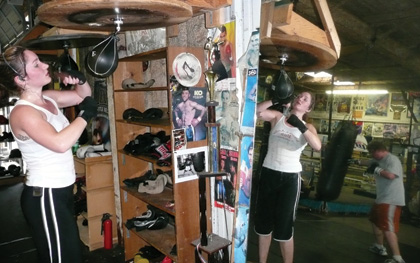
From a noisy, beer-in-hand evening screening to a subdued Saturday morning, we left international cricket grounds for a lowly neighbourhood boxing gym – Lord’s Gym in Austin, Texas, to be precise. Unlike cricket, with its documentary-unfriendly epic length of matches, boxing (and certainly its stars) have enjoyed a lot of cinema time. But I’ll bet there’s not a film about the sport quite like Frederick Wiseman’s. As ever, the master of meditative observational documentary takes the opposite tack to Riley: no musical interludes or nattering heads, just 91 minutes in the care of gym proprietor Richard Lord.
The first thing that hits you is the soundtrack: the deep breaths, the drumbeat of gloves hitting bags over and over again, and that beep of the countdown clock which bludgeons your ear. Weirdly, though, the boxing itself never feels very violent. We don’t see any actual fights and in only two short scenes is there proper sparring. Instead Wiseman, chronicler of American institutions that he is, prowls this compact, poster-filled warehouse observing people at work: boxers bandaging their hands, practising their footwork and enduring some arduous exercise regimes. Wiseman’s last film La Danse The Paris Opera Ballet was fixated with the human body. Despite concentrating largely on amateurs, Boxing Gym is no exception.
Occasionally in the film we listen to people conversing, about everything from discussions about work to the recent Virginia Tech shootings. But only once do we hear what sounds like macho bravado. Compared to the exclusively white and ego-filled domain of the Paris ballet, Lord’s Gym is another world. All types come here, from chubby street fighters to beefy pros, small girls to a 69-year-old grandma – there’s even a baby in the corner. While this shabby gym run by one man in a suburban backwater clearly lacks the scale and achievements of the Paris Ballet, you definitely get the sense that the institution itself is closer to Wiseman’s heart.
« Week one
See also
London Film Festival 2010: 30 recommendations (online, October 2010)
Pi reviewed by Mark Sinker (January 1999)
The Fountain reviewed by Michael Atkinson (March 2007)
Mumbai rising: Danny Boyle tells Alkarim Jivani about filming Slumdog Millionaire (February 2009)
The Beach reviewed by Xan Brooks (March 2000)
Mexico rising: Raúl Ruiz interviewed by Nick James (January 2006)
La Danse The Paris Opera Ballet reviewed by Kate Stables (May 2010)
Reflections in a golden eye: Nicolas Rapold hails Fred Wiseman’s respect for civic institutions and his artistry (September 2008)
